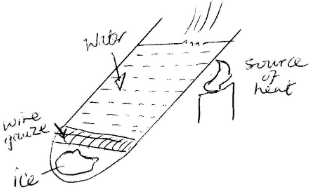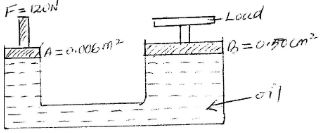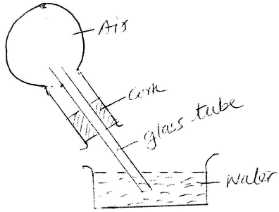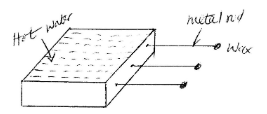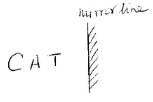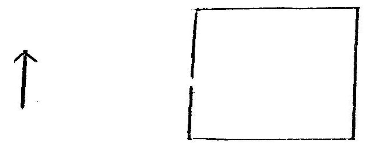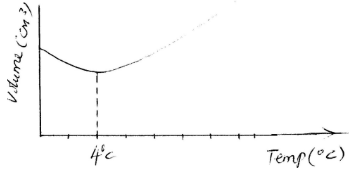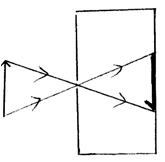- Write your name and admission number.
- Answer all the questions in the spaces provided after every question.
- All working for numerical questions must be clearly shown.
SECTION A (42MKS)
-
- Mention 2 branches of physics (2mks)
- State the relationship between Physics and Biology (1mks)
-
- What do you understand by S.I units? (1mk)
- Differentiate between derived physical quantities and basic physical quantities giving an example of each. (4mks)
- Complete the table below
Each ½ mark total = 3 marksBasic Quantitites SI Unit Symbol Mass Kg Electric current Ampere Temperature Amount of substance Mol Length m
-
- Define force, stating its SI unit. (2mks)
- State two (2) effect that a force can have when it acts on a body in a particular direction (2mks)
-
- Define pressure and state its S.I. unit of measurement.
- A block of copper of density 8900 kg/m3 measures 0.05m x 0.03m x 0.02m. Given that the gravitational field strength, g is 10N/kg, determine the minimum pressure that it can exert on a horizontal surface.
-
- Some amount of water is heated and its temperature rises from 0°C to 15°C. Sketch a graph of volume against temperature (2mks)
- State two disadvantages of anomalous expansion of water.
- In an experiment, the set up shown below was used. The ice remained in the solid state for several minutes while the water on the upper part of the boiling tube boiled.
- What is the purpose of the wire gauze? (1mk)
- Why did ice take that long to melt? (1mk)
- Explain the following.
- The feet feels colder when a person stands on cemented flour than when standing on a wooden floor. (1mk)
- Ventilation for a room is put nearer the roof of the room and not near the floor. (1mk)
-
- Define the following terms;
- A ray of light
- A beam of light (1mk)
- Calculate the angle between two mirrors such that the number of images formed is 5. (3mks)
- Define the following terms;
-
- What is electrostatics? (1mk)
- State the basic law of electrostatic charges. (1mks)
- Explain why a glass window soon becomes dusty after it has been wiped with a dry piece of cloth. (1mk)
- State three (3) uses of an electroscope. (3mks)
-
- Define an electric current, stating its SI unit (2mks)
- Calculate the amount of current flowing through a bulb if 150 coulombs of charge flows through it in 1.25 minutes. (3mks)
SECTION B (58MKS)
-
- State Pascal’s Principle
- The figure below shows a simple hydraulic machine used to raise heavy loads.
Calculate;- The pressure exerted on the oil by the force applied at A. (3mks)
- The load raised at B. (3mks)
- Give two properties which make the oil suitable for use in this machine. (3mks)
- What will be the effect of making cross- sectional areas A and B equal (1mk)
-
- Name two type of forces that determine the shape of liquid drop on a solid surface. (2mks)
- State two factors that affect the surface tension of a liquid (2mks)
- State three differences between mass and weight (3mks)
- A man has a mass of 70kg. Calculate his weight on earth where gravitational field strength is 10 N/kg.
-
- Name three (3) states of matter. (3mks)
- Distinguish the three states of matter in term of arrangement of particles in each of state. (3mks)
- The figure below shows various changes of state marked with letters A, B, C, D, E and F.
Name each change of state. (2mks) - Matter can exist in three states, solid, liquid or gas. Complete the table below by filling in the state best described by each molecular property listed. (2mk)
Molecular properties State a Closely packed b Spacing very large c Moving independently d Very strong force of attraction
-
- The figure below shows a bimetallic strip at room temperature. Brass expands more than invar when heated equally
Sketch the bimetallic strip after being cooled several degrees below room temperature. (2mks) - The figure shows a flask with a glass tube dipped into a beaker containing water at room temperature. The cork fixing the glass tube to the flask is airtight.
Use the information to answer question below
State what is observed when ice –cold water is poured on flask. (1mk) - Give a reason for the observation above. (2mks)
- State two advantages of mercury over alcohol as a thermal liquid. (2mks)
- State two factors that must be controlled in an experiment for comparing thermal conductivities of different metal rods. (2mks)
- The figure below shows a hot water bath with metal rods inserted through one of its end. Some wax is fixed at the end of each rod.
- What property of metals could be tested using this set-up? (1mk)
- Besides the length of the rods that is kept what else should be kept constant when comparing the property for the different metal rods. (1mk)
- The figure below shows a bimetallic strip at room temperature. Brass expands more than invar when heated equally
-
- What property of light is suggested by the formation of shadows. (1mk)
- What is a virtual image? (1mk)
- The figure below shows letters infront of a mirror. Draw the images of the letters behind the mirror. (2mks)
- State the law of reflection. (2mks)
- The figure below shows a ray of light being reflected from a plane mirror
The mirror is rotated clockwise through 20o keeping the incident ray fixed. What is new angle of reflection? (3mks) - Calculate to angle between two mirrors such that the number images formed are 5. (2mks)
-
- Define the term magnification as used in pin-hole camera. (1mk)
- The figure below shows a pin-hole camera.
Sketch the rays show how the image is formed on the screen. (2mks) - A Pinhole camera is placed 10m away from tree of height 5m. Calculate.
- The size of the image if the camera is magnification is 0.02. (2mks)
- The distance between the screen of the camera and the pinhole. (2mks)

MARKING SCHEME
SECTION A (42MKS)
-
- Mention 2 branches of physics (2mks)
- Thermodynamics, Atomic, Geometric, Wave, magnetism and electrical
- State the relationship between Physics and Biology (1mks)
- The knowledge of lenses has helped in the making of the microscope which assists in the study of the cell, the basic unit of life.
- Mention 2 branches of physics (2mks)
-
- What do you understand by S.I units? (1mk)
- There are units that that are internationally agreed on for use in measuring a given quantity.
- Differentiate between derived quantity and basic quantity giving an example of each. (4mks)
- Basic quantities are quantities that cannot be obtained from any other physical quantities while derived quantity are obtained from basic quantity by either multiplying or dividing.
- Examples Basic: Length, time, mass, current etc
- Derived: Area, volume, density,
- complete the table below
Basic Quantitites SI Unit Symbol Mass Kilogram Kg Electric current Ampere A Temperature Kelvin K Amount of substance Mole Mol Length Metre m
- What do you understand by S.I units? (1mk)
-
- Define force, stating its SI unit. (2mks)
- A force is a push or a pull.
- Its measured in Newtons.
- State two (2) effect that a force can have when it acts on a body in a particular direction (2mks)
- Make a stationary body to start moving
- Increase the speed of a moving body
- Slow down a moving body
- Stop a moving body
- Change the direction of a moving body
- change the shape of body Any two
- Define force, stating its SI unit. (2mks)
-
- Define pressure and state its unit of measurement.
- Pressure is force acting normally (perpendicularly) per unit area. Its SI unit is Newton per square metre.
- A block of copper of density 8900 kg/m 3 measures 0.05m x 0.03m x 0.02m. Given that the force of gravity is 10N/kg, determine the minimum pressure that it can exert on a horizontal surface.
Maximum surface area = 0.05 x 0.03 = 00015m2
Minimum pressure = 8900 × 10 × 0.05 × 0.03 × 0.02 = 1780 N/M2
0.0015
- Define pressure and state its unit of measurement.
-
- Some amount of water is heated and its temperature rises from to. Draw a graph of volume against temperature (2mks)
- State two disadvantages of anomalous expansion of water.
- Formation of icebergs that makes it difficult for sailors to sail.
- Breaking of water pipes during winter.
- In an experiment set up shown below, the ice remains in the sound state for several minutes as heating progressed.
- What is the purpose of the wire gauge (1mk)
- To trap and maintain the ice below the water ice is less dense, without the wire gauze, it will float on the surface.
- Why do ice takes too long to melt. (1mk)
- Heat conduction is very slow in water.
- What is the purpose of the wire gauge (1mk)
- Explain the following.
- The feet of a person feel colder when a person stands on cemented flour than when on a wooden floor. (1mk)
- Cemented floor is better conductor of heat than wooden floor hence cemented floor conducts heat away from feet faster hence feet feel colder.
- Ventilation for a room is put nearer the roof of the room and not near the floor. (1mk)
- The warm less dense air rises up and escapes through the ventilation.
- The feet of a person feel colder when a person stands on cemented flour than when on a wooden floor. (1mk)
- Some amount of water is heated and its temperature rises from to. Draw a graph of volume against temperature (2mks)
-
- Define the following terms;
- A ray of light
- Path along which light travels.
- A beam of light (1mk)
- Collection of rays.
- A ray of light
- Calculate the angle between two mirrors such that the number of images formed is 5. (3mks)
n = 360 −1
θ
5 = 360 −1
θ
60 = 360
θ = 360 = 60°
6
- Define the following terms;
-
- What is electrostatics (1mk)
- The study of static charges
- State the basic law of electrostatic charges. (1mks)
- Like charges repel while unlike charges attract.
- Explain why a glass window soon becomes dusty after it has been wiped with a dry piece of cloth. (1mk)
- Rubbing charges the glass by friction. Dust particles are hence attracted to the charged glass.
- State three (3) uses of an electroscope. (3mks)
- Testing the presence of charge
- Identify the type of charge
- Testing insulating properties of materials
- comparing the amount charge on two or more identical bodies.
- What is electrostatics (1mk)
-
- Define electric current, stating its SI unit (2mks)
- Electric current is the rate of flow of charge. It’s expressed in Amperes.
- Calculate the amount of current flowing through a bulb if 150 coulombs of charge flows through it in 1.25 minutes. (3mks)
I = Q/t
= 150
1.25 × 60
= 150
75
= 2A.
- Define electric current, stating its SI unit (2mks)
SECTION B (58MKS)
-
- State Pascal’s Principle
- Pressure applied of one point in a liquid is transmitted equally to all other parts of the enclosed liquid.
- Pressure applied of one point in a liquid is transmitted equally to all other parts of the enclosed liquid.
- The figure below shows a simple hydraulic machine used to raise heavy loads. Calculate;
- The pressure exerted on the oil by the force applied at A. (3mks)
P = F = 120 = 20,000 N/m2
A 0.006 - The load raised at B. (3mks)
F = P x A
= 20,000 x 0.50
= 10,000N. - Give two properties which make the oil suitable for use in this machine. (3mks)
- Should be incompressible
- Should be non- corrosive
- Should have high boiling point and low freezing point. Any 2
- The pressure exerted on the oil by the force applied at A. (3mks)
- What will be the effect of making cross- sectional areas A and B equal (1mk)
- Force F required to be applied on A will be more
- State Pascal’s Principle
-
- Name two type of forces that determine the shape of liquid drop on a solid surface. (2mks)
- Cohesive force
- Adhesive force
- State two factors that affect the surface tension of a liquid (2mks)
- Temperature
- Impurities
- State three differences between mass and weight (3mks)
Mass Weight -Quantity of matter in a body
-SI unit is kilogram
-Measured using beam balance
-Scalar quantity
-Constant everywhere- Pull of gravity on a body
- SI unit is newton
- Measuring using spring balance
- Vector quantity
- Changes from place to place - A man has a mass of 70kg. Calculate his weight on earth where gravitational field strength is 10N/kg.
W = mg
= 70 x 10
= 700N
- Name two type of forces that determine the shape of liquid drop on a solid surface. (2mks)
-
- Name three (3) states of matter. (3mks)
- solid
- liquid
- gases
- Distinguish the three states of matter in term of arrangement of particles in each of state. (3mks)
- Solid; - Particles closely packed together and held together by strong cohesive forces.
- Liquids: - particles are further apart and the cohesive forces are weaker than in solids.
- Gases: - Particles are much further apart than those in liquids. Cohesive forces are very weak.
- The figure below shows various changes of state marked with letters A,B,C,D, E and F. Name each change of state. (2mks)
- A Vaporization
- C Freezing
- B Condensation
- D Sublimation
- Matter can exist in three states, solid, liquid or gas. Complete the table below by filling in the state best described by each molecular property listed. (2mk)
Molecular properties State a Closely packed Solid b Spacing very large Gases c Moving independently Liquid/Gases d Very strong force of attraction Solid
- Name three (3) states of matter. (3mks)
-
- The figure below shows a bimetallic strip at room temperature. Brass expands more than invar when heated equally
Sketch the bimetallic strip after being cooled several degrees below room temperature. (2mks) - The figure shows a flask with a glass tube dipped into a beaker containing water at room temperature.The cork fixing the glass tube to the flask is airtight. Use the information to answer question below. State what is observed when ice –cold water is poured on flask. (1mk)
- Water rises up through the glass tube into the flask.
- Give a reason for the observation above. (2mks)
- The ice cold water causes air inside the flask to contract. The pressure of the air inside decreases and the high atmospheric pressure pushes the water up.
- State two advantages of mercury over alcohol as a thermal liquid. (2mks)
- It has higher boiling point
- Good thermal conductor
- Does not require coloring
- Does not wet the glass Any 2
- State two factors that must be controlled in an experiment for comparing thermal conductivities of different metal rods. (2mks)
- Temperature difference
- Cross- section area
- Length of conductor Any 2
- The figure below shows a hot water bath with metal rods inserted through one of its end. Some wax is fixed at the end of each rod.
- What property of metals could be tested using this set-up? (1mk)
- Thermal conductivity
- Besides the length of the rods that is kept what else should be kept constant when comparing the property for the different metal rods. (1mk)
- Cross-sectional area
- What property of metals could be tested using this set-up? (1mk)
- The figure below shows a bimetallic strip at room temperature. Brass expands more than invar when heated equally
-
- What property of light is suggested by the formation of shadows. (1mk)
- Light travels in a straight line.
- What is a virtual image? (1mk)
- It’s an image that cannot be formed on the screen and therefore is formed by imaging rays.
- The figure below shows letters infront of a mirror. Draw the images of the letters behind the mirror. (2mks)
- Approximate image distance
- Characters facing the right side
- State the law of reflection. (2mks)
- The angle of incidence is equal to the angle of reflection.
- Incidence ray and normal lies at the same plane at the point of incident.
- The figure below shows a ray of light being reflected from a plane mirror. The mirror is rotated clockwise through 20 o keeping the incident ray fixed. What is new angle of reflection? (3mks)
<i = 70/2 = 35
Reflected ray shift by 2 x 20 = 40°
New angle = 35 + 40 = 75° - Calculate to angle between two mirrors such that the number images formed are 5. (2mks)
5 = 360 – 1
θ
6 = 360
θ
θ = 60°
- What property of light is suggested by the formation of shadows. (1mk)
-
- Define the term magnification as used in pin-hole camera. (1mk)
- Magnification is the ratio of image size to the object size.
- The figure below shows a pin-hole camera.
Sketch the rays show how the image is formed on the screen. (2mks) - A Pinhole camera is placed 10m away from tree of height 5m. Calculate.
- The size of the image if the camera is magnification is 0.02. (2mks)
0.02 = h image = h
h object 5
h = 0.02 x 5 = 0.1 m or 10cm - The distance between the screen of the camera and the pinhole. (2mks)
0.02 = v/10
v = 0.02 x 10
= 0.2m or 20cm.
- The size of the image if the camera is magnification is 0.02. (2mks)
- Define the term magnification as used in pin-hole camera. (1mk)
Download Physics Questions and Answers - Form 2 Term 1 Opener Exams 2023.
Tap Here to Download for 50/-
Get on WhatsApp for 50/-
Why download?
- ✔ To read offline at any time.
- ✔ To Print at your convenience
- ✔ Share Easily with Friends / Students

